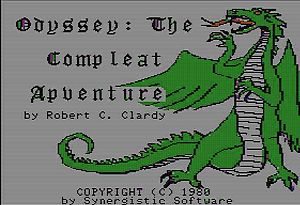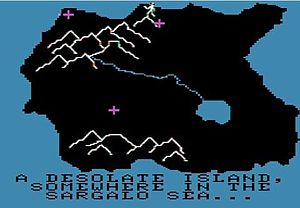- Odyssey: The Compleat Apventure
-
Odyssey: The Compleat Apventure was a videogame written by Robert Clardy and released by Synergistic Software in 1980. It was created for the Apple II platform and is considered one of the first microcomputer-based role playing games. The title was intentionally misspelled; Apventure is a reference to the Apple computer.
A forerunner of Akalabeth and Ultima, Odyssey was a multi-part adventure game that placed the player in the role of the leader of an army who sets out to vanquish an evil wizard. Elements of Dungeons & Dragons can be found within the game, which combines elements of two earlier games written by Clardy: Dungeon Campaign and Wilderness Campaign.
Contents
Game overview
The game features several major sections. Except for the endgame section, the game play is presented in a top-down map format with limited animation and sound effects.
Part 1
The game starts on an uncharted island in the Sargalo Sea, where the player and a small group of men have to search the island for castles, ruins and temples, wherein they can find randomly placed treasure and valuable magical items. Along the way, the game generates random encounters with monsters, warriors, rogues, and wizards. Some wizards and warlocks encountered might be kindly disposed towards the player and provide magical items, while others may attack on sight. Similarly, some groups of rogues and warriors encountered might choose to join the player's group rather than fight.
Combat is conducted using a random number generator - the party with the higher number during a round inflicts damage on the enemy, with damage gauged by the number of men/creatures killed. When a group reaches zero members, the team is defeated. The player's "roll" is determined by the number of men, their strength and experience, and the type and quantity of weapons and armor carried.
For the player, maintaining a large army is necessary in order to continue to carry gold, treasure, and necessities such as weapons. The fewer men in a party, the fewer items that can be carried. Men can be added to the team by having groups of warriors and rogues agree to join; a more expensive way of adding men is to purchase contracts that periodically become available for sale. Three randomly scattered towns allow the player to purchase food (which must be replenished) and goods such as lockpicks that allow access to some structures. The type and quantity of goods available for purchase are randomly generated. The player also encounters the occasional caravan from which goods can be purchased - or, the player may choose to attack the caravan; if the caravan is defeated, the team receives the spoils which consists of a number of random items that may or may not be useful.
The towns are not explored. Instead, the player is automatically taken to the market where bartering for goods occurs. The player can choose to pay the full price, or can negotiate for a lower fee. Depending on the player's charisma level (set at the start of the game), the merchants may agree to charge less, or they may get upset at a low bid and remove an item from sale completely (which can be hazardous to the player if the item removed for sale happens to be badly needed food). Merchants are replenished after the player leaves the town and has an encounter of some sort. Caravans work the same ways as towns, except as they are randomly encountered one has only a single chance to strike a deal. Occasionally, huts are encountered in the wilderness where the player can gamble a (usually large) amount of gold for an alleged magic item that may or may not be any good.
Gold is accumulated from chests and other sources, including magical scrolls; the higher the party's wisdom score is, the more gold is obtained from a scroll.
Travel around the island can be slow and dangerous, and items purchased by the player may be necessary to pass through obstacles or avoid loss of men. (For example, if the player has a shovel, men can be rescued from avalanches and cave-ins; a machete may be needed to pass through dense jungle; an amulet is needed to cure swamp fever, etc.) If a player is lucky, a magic carpet might be found in a chest or be obtained from a friendly wizard or warlock. This allows quick travel across the island; riding a magic carpet avoids monster battles but also skips over buildings and ruins that may contain treasure. Horses can also be obtained with a similar effect; however, the player must have a sufficient quantity of horses to carry the team, while only one magic carpet is required.
The ultimate goal of the island section of the game is to collect enough gold to purchase a ship (which is usually available at only the one town closest to the northwest corner of the island) and also to collect ample magical objects and other items (mirrors, wooden planks, even a monkey or two) which will be needed later in the game.
Part 2
The game then becomes a sea expedition, with the player navigating his/her vessel between several islands. Among hazards that must be dealt with: pirate attacks, unpredictable winds, whirlpools, scurvy among the crew, falling off the edge of the world, and rotting sails. How well the player is able to cope with these hazards depends upon how well stocked the player's team became on the main island. (Once Part 2 begins, the island can no longer be accessed.) Merchant vessels may also be encountered - with the player having the same options as with caravans, attack or barter. After leaving the island, this is the only easy way to obtain necessary items such as fruit, spare sails, and weapons (however the player is no longer required to be continually stocked with regular food). The group may also encounter pirates, whirlpools, birds, and other hazards that can kill men and damage the ship.
The map of islands in the Sargalo Sea in which you navigate your ship consists of a ring of islands around the perimeter of the screen. Your ship starts out next to the island you just left (in the lower right of the screen) while the island of the evil wizard (your goal) is in the upper left. You may land on other islands to stock up on food and resources but for the most part these islands are not fully exporable as the first one was, and serve only as places to stock up on supplies by displaying a few lines of text after you land (with one exception—see below). Navigation is a complex scheme, as you are at the mercy of wind and currents (and whether the vessel has any intact sails left) and you cannot navigate directly as you can in early Ultima titles. You must set the sails in different directions in order to catch the wind, and raise and lower anchor to start and stop your ship. Hazards include running aground if the player weighs anchor too close to shore, and falling off the edge of the world if the ship gets too close to the edge of the map.
During this segment of the game, the goal is to discover a magical weapon and take it to the evil wizard's island in order to defeat him and become the ruler of the land. The weapon can be discovered in one of two ways. While sailing, the player may encounter the god Poseidon who will tell the player where a great treasure may be found (the player's ability to find the treasure will depend upon whether he/she was able to obtain a sextant during the island expedition). If you sail to the proper coordinates in the sea and search, you will find the item. The other way is that one of the islands will randomly contain a blocky, lo-res graphical dungeon (somewhat similar to the Clardy's earlier Dungeon Campaign game) whose corridors reveal themselves to you and are added to the map as you wander through them. The team runs into random hazard encounters along the way (such as cave-ins, poison gas, and wandering monsters) and eventually finds the magical orb. (In order to access this dungeon, however, you must first tithe a magical item, provided you have any left.)
Part 3 (endgame)
During the final segment of the game, the screen returns to a view of an island, similar to that in part one except that there is a large castle drawn in the middle of the screen which the player approaches from the bottom. Although it looks similar, gameplay does not consist of free movement as it did on the first island. Instead the player advances upon the evil castle, a series of three overcoming randomized obstacles placed in his/her way such as walls, giant pits, etc. (like most obstacles in the game, these are described in text rather than actually seen). The player's ability to get past these obstacles with minimal damage/loss of men depends upon what items have been kept in inventory. Seemingly innocuous items found on the main island early in the game such as mirrors and monkeys which served no purpose, are often essential to overcoming the obstacles here. (For example, a monkey is needed to unlock a door; mirrors can protect against damage from Medusa). If the team makes it to the castle, a great battle ensues, which the player invariably wins so long as the team has a fair number of men. The game ends with a tally of how many creatures the player's team killed, how large the team became, etc.
There is a sequel to Odyssey: The Compleat Apventure called Apventure to Atlantis whose story picks up with the player as ruler of this island.
Graphics and technology
Although primitive by today's standards, Odyssey was considered cutting-edge for its time, making use of the Apple II's two graphics modes (high-resolution and low-resolution), and text. The game was written in Integer BASIC and was one of the first microcomputer games to be created using multiple programs, requiring floppy disc activation and access mid-game. (This feature, however, led to a way in which the player could cheat: by removing the disk when the computer required access, a cursor flashes on screen; typing "goto 770" would fool the computer into thinking that the player had just opened up a treasure box. This is one of the earliest known examples of a cheat code.) Prior to this, most games were self-contained, single programs; Odyssey was split into several different programs and took up an entire disk. The game also made use of rudimentary sound effects.
Categories:- 1980 video games
- Apple II games
- Apple II-only games
- Adventure games
- Synergistic Software games
Wikimedia Foundation. 2010.


